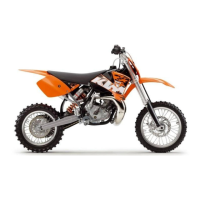14 COOLING SYSTEM 62
14.1 Cooling system
601959-10
The water pump 1 in the engine forces the coolant to flow.
The pressure resulting from the warming of the cooling system is regulated by a valve
in the radiator cap 2. This ensures that operating the vehicle at the specified coolant
temperature will not result in a risk of malfunctions.
120 °C (248 °F)
Cooling is effected by the air stream.
The lower the speed, the less the cooling effect. Dirty cooling fins also reduce the cool-
ing effect.
14.2 Checking the antifreeze and coolant level
Warning
Danger of scalding During motorcycle operation, the coolant gets very hot and is under pressure.
– Do not remove the radiator cap, radiator hoses or other cooling system components when the engine is hot. Allow the
engine and cooling system to cool down. In case of scalding, rinse immediately with lukewarm water.
Warning
Danger of poisoning Coolant is poisonous and a health hazard.
– Coolant must not come into contact with the skin, eyes, or clothing. If contact occurs with the eyes, rinse with water imme-
diately and contact a physician. Immediately clean contaminated areas on the skin with soap and water. If coolant is swal-
lowed, contact a physician immediately. Change clothing that is contaminated with coolant. Keep coolant out of reach of
children.
Info
Carry out this work with a cold engine.
602691-10
– Stand the motorcycle upright on a horizontal surface.
– Remove radiator cap 1.
– Check the antifreeze of the coolant.
−25… −45 °C (−13… −49 °F)
» If the antifreeze of the coolant does not meet specifications:
– Correct the antifreeze of the coolant.
400243-10
– Check the coolant level in the radiator.
Coolant level A above the radiator fins 10 mm (0.39 in)
» If the level of the coolant does not meet specifications:
– Correct the coolant level.
Alternative 1
Coolant ( p. 81)
Alternative 2
Coolant (mixed ready to use) ( p. 81)
– Mount the radiator cap.

